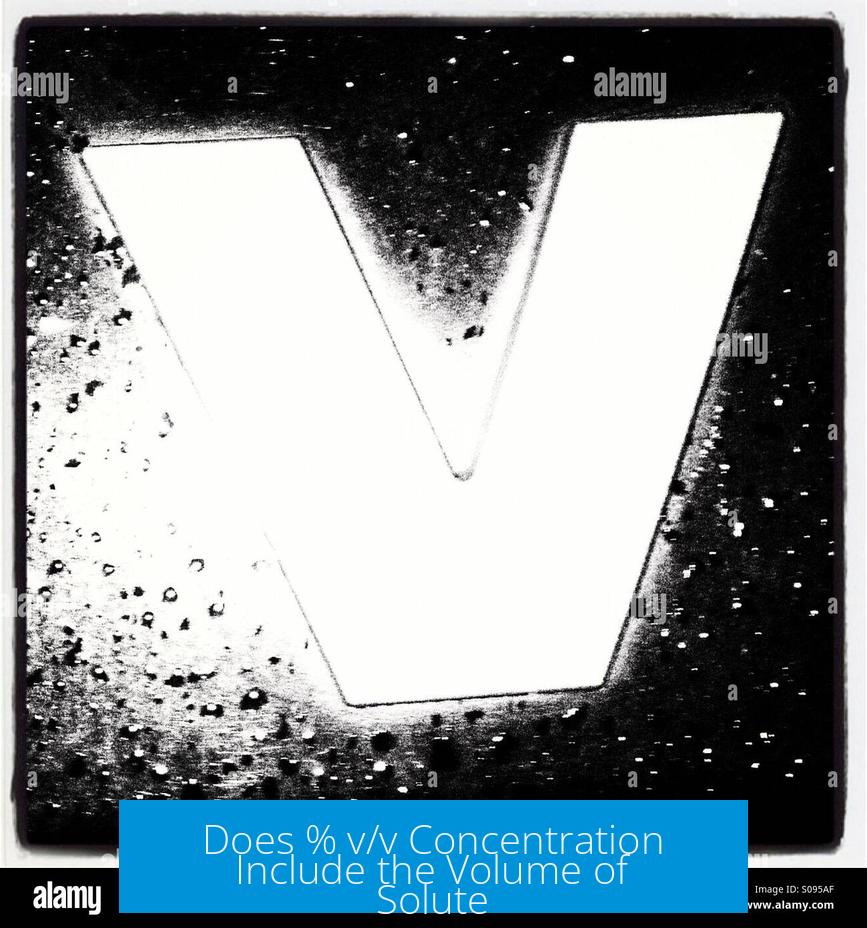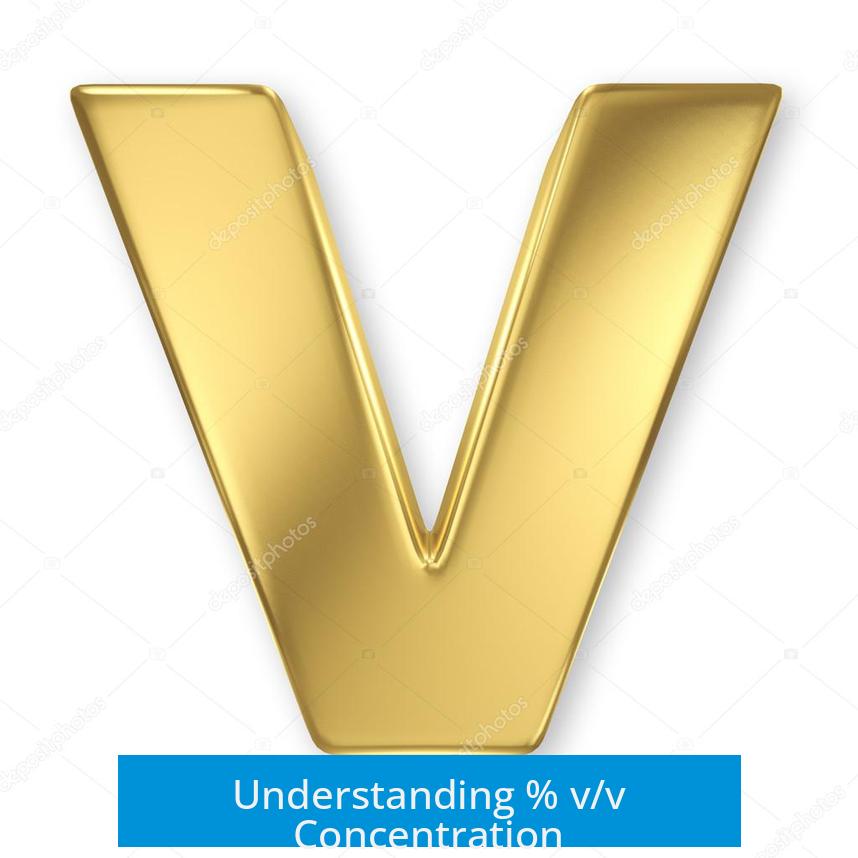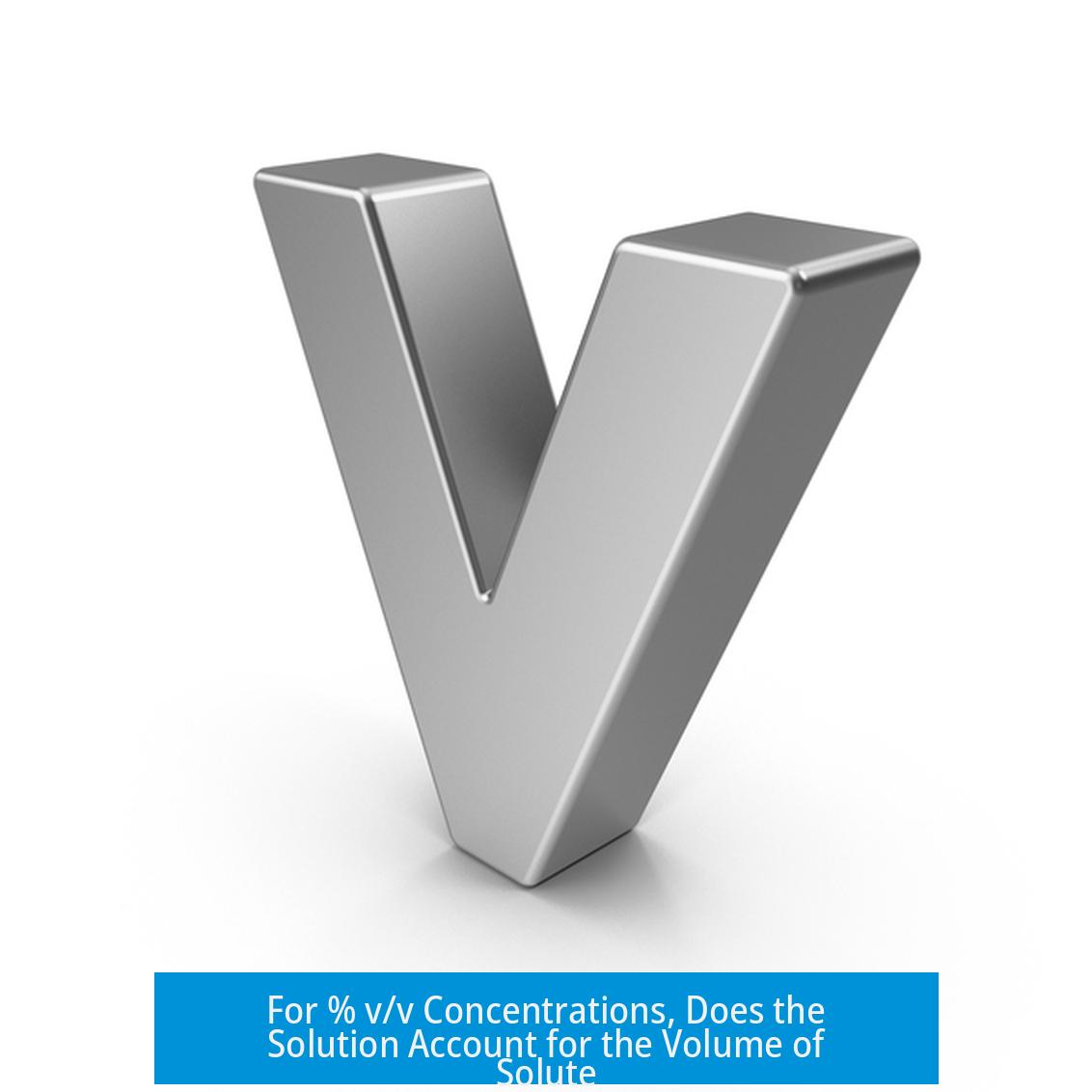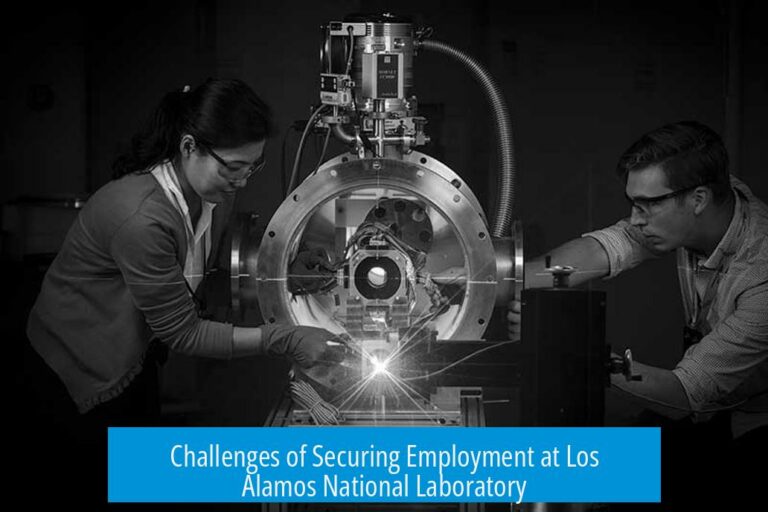Does % v/v Concentration Include the Volume of Solute?

Yes, for concentrations described as % v/v, the total solution volume includes the volume of the solute. This is because % v/v concentration is defined as the volume of solute divided by the total volume of the solution. However, this total volume is not always a simple sum of the solute and solvent volumes due to volume changes upon mixing.
Understanding % v/v Concentration

Volume/volume percent (% v/v) expresses the ratio of solute volume to total solution volume:
% v/v = (Volume of solute) / (Total volume of solution) × 100%
Here, the total volume includes both the solute and solvent volumes combined. In theory, this equals the sum of the solute volume plus solvent volume. In practice, slight volume changes occur when substances mix. This phenomenon, called volume of mixing, makes total volume slightly less or more than the simple additive volumes. Despite this, the % v/v definition assumes total volume includes the solute.
Applications in Dilution and Calculations

The % v/v measure is widely used in dilution calculations. For example, to dilute a solution with alcohol:
- Initial concentration (c1) and volume (v1) relate to final concentration (c2) and volume (v2) by c1v1 = c2v2.
- % v/v units fit directly into the dilution formula, so matching units on both sides allows for straightforward calculation.
This supports using % v/v concentrations confidently in preparing and diluting solutions where volume precision is important but volume change upon mixing is minimal or tolerable.
Limitations and Ambiguities with % v/v

While convenient, % v/v concentrations have limitations:
- Ambiguity in interpretation: A 10% v/v solution might mean different things depending on how it’s prepared—whether by mixing volumes to reach 100% or mixing fixed volumes.
- Volume changes upon mixing can introduce minor inaccuracies.
- % v/v is often better suited for approximate or non-precise applications, such as indicators or simple neutralizations.
Key Takeaways

- % v/v concentration includes the solute volume within the total solution volume.
- Total volume ≈ solute volume + solvent volume, adjusted for volume changes on mixing.
- % v/v fits well into dilution calculations via the formula c1v1 = c2v2.
- Be cautious of ambiguities and volume change effects when precision is critical.
For Concentrations Described as % v/v, Does the Solution Include the Volume of Solute?

Short answer? Yes, the solution volume absolutely includes the volume of solute when dealing with % v/v concentrations. But—and this is a juicy “but”—there’s a little chemistry magic happening behind the scenes that keeps things interesting. Let’s deep dive into the curious world of % v/v concentrations, what they mean, how they’re used, and some quirks you might not expect.
First things first, what exactly is % v/v? It stands for “volume per volume,” a way of expressing concentration by the volume of the solute relative to the total volume of the solution. Imagine pouring 10 mL of orange juice concentrate into a glass and filling the rest with water up to 100 mL total. The % v/v concentration here is 10%, meaning those 10 mL of concentrate make up 10% of the whole 100 mL drink.
The Definition Demystified: What Is % v/v Concentration?
When you see % v/v, think of it as volume of solute divided by the total volume of the solution. The “total volume” means the sum of the solute volume and the solvent volume after mixing, not just before mixing. But here’s the twist—unless your solute and solvent volumes magically stack like LEGO blocks, the total volume isn’t always the simple sum of their separate volumes.
This happens because of a phenomenon called volume of mixing. It’s the sneaky shrinkage or expansion of volume that occurs when two liquids mix. Some molecules fit snugly, squeezing out air or rearranging space, making the combined volume smaller or bigger than expected. So, 50 mL solute plus 50 mL solvent might create less or slightly more than 100 mL solution.
Despite this, % v/v still counts the solute volume as part of that total. The formula approximates the concentration like this:
% v/v = (Volume of solute) ÷ (Volume of solute + Volume of solvent, adjusted for volume of mixing) × 100
So yes, the solute’s volume is included. But because of volume changes, measuring exact volumes after mixing to prepare solutions might be tricky.
Why Does This Matter? Dilutions and Calculations Made Easy
Now, if you think this is just some chemistry trivia, think again! % v/v is highly practical in lab and industrial settings. Take alcoholic beverages, for example. If you want to dilute wine from 12% alcohol down to a gentler 8%, you use % v/v values along with the trusty dilution formula:
c1 × v1 = c2 × v2
“c” is concentration and “v” is volume. Using % v/v, you can plug in your initial alcohol content and volume, then calculate how much water to add for the target alcohol concentration.
This shortcut works smoothly because % v/v inherently factors solute volume into total volume. (Just remember that volumes at best approximate real mixtures.) The equation doesn’t fidget over units or precision—so long as you keep the units consistent, the math adds up.
Hold On! The Ambiguity of % v/v and When to Be Cautious
Here’s where the story thickens. Despite its utility, % v/v isn’t the golden child of precision. The term itself can be ambiguous. Sometimes, people say “10% v/v solution” and mean different things:
- 10 mL solute made up to 100 mL total volume by adding solvent
- 10 mL solute plus 90 mL solvent (exactly 100 mL total assumed)
- 10 mL solute plus 100 mL solvent (so final volume roughly 110 mL)
This inconsistency can muddle your expectations. For tough analytical work or pharmaceutical formulations demanding tight tolerances, relying solely on % v/v might cause headaches. It’s better suited when exact concentration isn’t vital—think cleaning solutions, titration indicators, or everyday chemistry in kitchens or classrooms.
That Volume of Mixing: The Curveball No One Warned You About
Ever tried mixing vodka and water and felt like something didn’t add up? That’s volume contraction at work. The volume of mixing may slightly contract or expand total solution volume, causing a minor deviation from expected % v/v concentration.
Let’s say you mix 30 mL of ethanol with 70 mL water expecting exactly 100 mL of solution. The real volume might be closer to 96 mL due to ethanol molecules nestling among water molecules. So, your calculated % v/v based on individual added volumes becomes a rough estimate.
This doesn’t invalidate % v/v as a concept—it remains a reliable guide, especially for approximate or routine purposes.
Summing It Up: What You Really Need to Know
- % v/v is the ratio of solute volume to total solution volume (which includes solute).
- Due to volume mixing effects, the final solution volume may not be the sum of separate solute and solvent volumes, so % v/v is an approximation.
- It’s perfect for quick dilutions and routine lab work but less ideal where absolute precision matters.
- Be aware of ambiguity in interpretation—clarify preparation methods when necessary.
Next time you see a % v/v label on a bottle or follow a dilution formula, you’ll know what’s really under the hood. Remember that solute volume counts, but molecules might cozy up in unexpected ways. Isn’t chemistry just delightfully complex?
So, how will you use this knowledge? Planning a science experiment? Cooking up a brewery batch? Or simply curious about your favorite cocktails? Share your experiences or questions!
Does % v/v concentration include the solute volume in the total solution?
Yes, % v/v is volume of solute divided by total solution volume. The total includes solute plus solvent, though volumes may not add exactly due to mixing effects.
Can I use % v/v concentrations in dilution calculations?
Yes. The % v/v format works well with dilution formulas like c₁v₁ = c₂v₂. Units must match, but % v/v can be used directly in these calculations.
Why can % v/v concentrations be ambiguous?
% v/v can mean different things depending on preparation. It might indicate volume of solute added to reach a total volume or volume ratios not strictly additive. This ambiguity limits precision.
Does mixing solute and solvent always add volumes exactly?
No. Volume changes on mixing occur, so solute volume plus solvent volume may not equal the total solution volume exactly.
When is % v/v concentration commonly used despite its limitations?
It is used when precision is not critical, such as in titration indicators or solutions made with approximate volumes. Its simplicity outweighs exact accuracy in these cases.




Leave a Comment